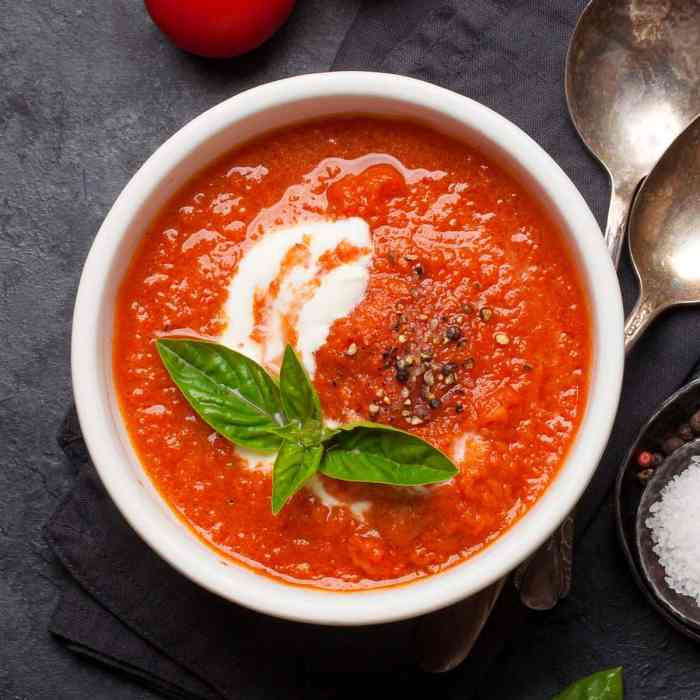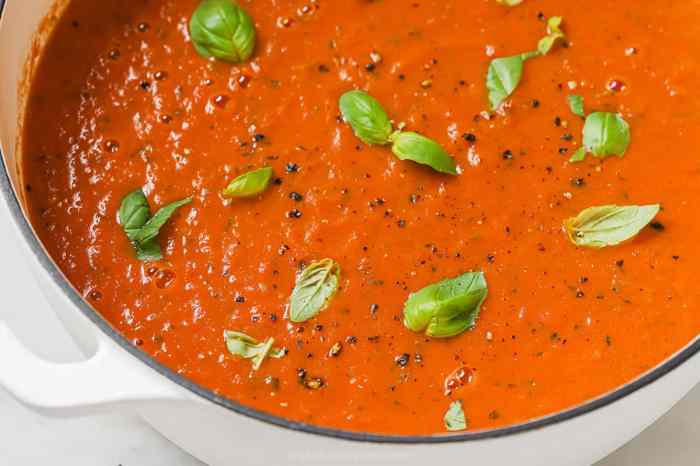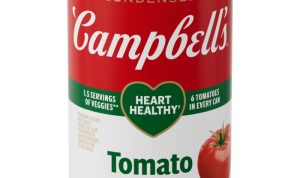Basil Tomato Soup: A Culinary Exploration: Basil Tomato Soup Recipe
Basil tomato soup recipe – The humble tomato, a canvas of vibrant red, holds within it a world of flavor possibilities. Paired with the fragrant basil, a symphony of taste unfolds, creating a soup that’s both comforting and sophisticated. This exploration delves into the versatile world of basil tomato soup, revealing its many facets through variations, cooking methods, ingredient substitutions, serving suggestions, nutritional aspects, and storage techniques.
Recipe Variations
Three distinct variations showcase the adaptability of this classic soup: a classic version, a vibrant vegan alternative, and a richly flavored roasted vegetable rendition. Each recipe offers a unique textural and gustatory experience.
| Name | Quantity | Unit | Notes |
|---|---|---|---|
| Classic Basil Tomato Soup | |||
| Canned Tomatoes | 28 | oz | Use high-quality canned tomatoes for best flavor. |
| Vegetable Broth | 4 | cups | Low sodium preferred. |
| Fresh Basil | 1 | cup, packed | Leaves only, roughly chopped. |
| Onion | 1 | medium, chopped | Sweet onion recommended. |
| Garlic | 2 | cloves, minced | Fresh garlic adds depth of flavor. |
| Olive Oil | 2 | tablespoons | Extra virgin olive oil is ideal. |
| Salt and Pepper | To taste | Adjust to your preference. | |
| Vegan Basil Tomato Soup | |||
| Canned Tomatoes | 28 | oz | Use high-quality canned tomatoes. |
| Vegetable Broth | 4 | cups | Ensure it’s low sodium and vegan-friendly. |
| Fresh Basil | 1 | cup, packed | Leaves only, roughly chopped. |
| Onion | 1 | medium, chopped | Sweet onion recommended. |
| Garlic | 2 | cloves, minced | Fresh garlic adds depth of flavor. |
| Olive Oil | 2 | tablespoons | Extra virgin olive oil is ideal. |
| Nutritional Yeast | 2 | tablespoons | Adds a cheesy flavor. |
| Salt and Pepper | To taste | Adjust to your preference. | |
| Roasted Vegetable Basil Tomato Soup | |||
| Canned Tomatoes | 28 | oz | Use high-quality canned tomatoes. |
| Vegetable Broth | 4 | cups | Low sodium preferred. |
| Fresh Basil | 1 | cup, packed | Leaves only, roughly chopped. |
| Roasted Vegetables | 2 | cups | (e.g., carrots, zucchini, bell peppers) |
| Onion | 1 | medium, chopped | Sweet onion recommended. |
| Garlic | 2 | cloves, minced | Fresh garlic adds depth of flavor. |
| Olive Oil | 2 | tablespoons | Extra virgin olive oil is ideal. |
| Salt and Pepper | To taste | Adjust to your preference. | |
The classic version offers a balanced, familiar taste. The vegan variation, enhanced by nutritional yeast, provides a savory, umami depth. The roasted vegetable soup boasts a richer, more complex flavor profile due to the caramelization of the vegetables during roasting, adding sweetness and earthiness.
Texturally, the classic and vegan soups have a smooth, consistent texture achieved through blending. The roasted vegetable soup, however, offers a slightly chunkier texture due to the inclusion of roasted vegetables, adding a delightful textural contrast.
Cooking Methods
Three methods – stovetop, immersion blender, and slow cooker – offer diverse approaches to crafting this soup.
Stovetop Method:
- Sauté onion and garlic in olive oil until softened.
- Add canned tomatoes, vegetable broth, and basil. Bring to a simmer.
- Simmer for 15-20 minutes, allowing flavors to meld.
- Blend using a regular blender or immersion blender until smooth.
- Season with salt and pepper to taste.
Immersion Blender Method: This method simplifies the process by eliminating the need for transferring the hot soup to a blender. However, it may not achieve the same level of smoothness as a regular blender.
Slow Cooker Method:
- Combine all ingredients in a slow cooker.
- Cook on low for 6-8 hours or high for 3-4 hours.
- Blend using an immersion blender until desired consistency is reached.
- Season with salt and pepper to taste.
Adjustments for the slow cooker method include increasing the cooking time to allow the flavors to fully develop. The slow cooking process results in a tender, well-integrated flavor profile.
Ingredient Substitutions, Basil tomato soup recipe
Several substitutions can be made to adapt the recipe to individual preferences and dietary needs.
Basil Substitutes: Fresh oregano or parsley can substitute for basil, though they will impart slightly different flavor profiles. Oregano provides a more pungent, earthy note, while parsley offers a brighter, more herbaceous flavor. Dried basil can be used, but use about one-third the amount of fresh basil.
Tomato Substitutes: Fresh tomatoes can replace canned tomatoes, but require additional cooking time. Tomato paste can add depth and richness, but use it sparingly to avoid an overly concentrated flavor.
Broth Substitutes: Chicken broth can be used instead of vegetable broth, adding a richer, more savory flavor. Water can be used as a last resort, but it will result in a less flavorful soup.
Serving Suggestions

Source: avirtualvegan.com
Enhance the enjoyment of basil tomato soup with a selection of complementary toppings and accompaniments.
- Croutons: Add a delightful crunch and savory element.
- Fresh Parmesan Cheese: Offers a salty, sharp counterpoint to the sweetness of the tomatoes.
- A swirl of cream or coconut cream (for vegan option): Adds richness and a velvety texture.
A simple grilled cheese sandwich pairs perfectly with the soup. Use sourdough bread for its tangy flavor and a blend of cheddar and Gruyère cheese for a rich, nutty taste. The slightly crisp exterior of the grilled cheese contrasts beautifully with the warm, smooth soup.
For a visually appealing presentation, serve the soup in rustic bowls. A simple garnish of fresh basil leaves adds a pop of color and enhances the aromatic experience. A drizzle of high-quality olive oil creates a glistening surface, enhancing the visual appeal.
Nutritional Aspects

Source: joyfulhealthyeats.com
Basil and tomatoes are nutritional powerhouses, rich in vitamins and antioxidants. Basil is a good source of vitamin K and antioxidants, while tomatoes are packed with vitamin C and lycopene, a powerful antioxidant linked to various health benefits.
To reduce sodium content, use low-sodium or no-salt-added canned tomatoes and vegetable broth. Herbs and spices can enhance flavor without adding sodium. Fresh herbs like basil, oregano, or thyme can elevate the flavor profile.
| Nutrient | Amount | Unit | % Daily Value |
|---|---|---|---|
| Calories | 150 | kcal | 7.5% |
| Fat | 5 | g | 7.5% |
| Protein | 5 | g | 10% |
| Carbohydrates | 25 | g | 8.3% |
Note: Nutritional values are estimates and may vary based on specific ingredients and portion sizes.
Storage and Reheating

Source: happyfoodstube.com
Proper storage and reheating methods ensure the soup maintains its quality and safety.
Store leftover soup in an airtight container in the refrigerator for up to 3 days. Reheating can be done in the microwave, stovetop, or even gently on the stovetop. Microwaving is quick and convenient, but may result in a slightly altered texture. Stovetop reheating offers better control over the temperature and consistency.
Freezing the soup is possible. To prevent ice crystal formation, allow the soup to cool completely before transferring it to freezer-safe containers, leaving some headspace for expansion. The frozen soup should retain its quality for up to 3 months.
Answers to Common Questions
Can I use frozen tomatoes?
Yes, frozen tomatoes work well, but you may need to adjust the cooking time slightly as they contain more water. Thaw them completely before using.
What if I don’t have an immersion blender?
A regular blender works perfectly! Just be careful when blending hot liquids – vent the lid to release steam and avoid burns.
How long can I store leftover soup?
Store leftover soup in an airtight container in the refrigerator for up to 3-4 days. Always allow the soup to cool completely before refrigerating.
Can I make this soup ahead of time?
So you’re craving a vibrant basil tomato soup, right? Something bright and summery to tickle your tastebuds? Well, if you’re feeling adventurous and want to explore other creamy soup options, check out these amazing ideas for recipes with cream of corn soup , they’re surprisingly versatile! But honestly, nothing beats a good basil tomato soup – unless you’re suddenly craving cornbread, in which case, that’s a whole other culinary adventure.
Absolutely! This soup tastes even better the next day. Prepare it a day or two in advance for a truly effortless meal.






